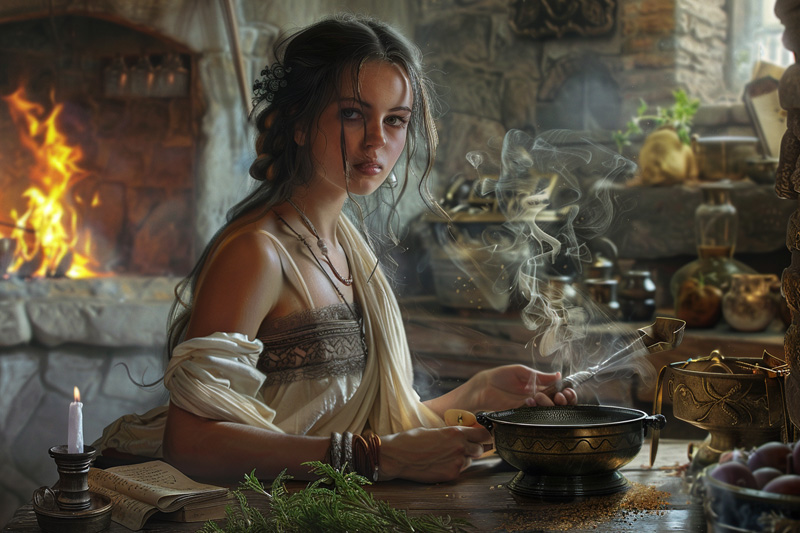KidZone Geography: Greek Mythology
About Hestia, Goddess of the Hearth
Introduction to Hestia
Hestia, one of the twelve Olympian deities in Greek mythology, is the goddess of the hearth, home, and family. Known for her gentle and nurturing nature, Hestia is often depicted with a flame, symbolizing the hearth fire that provides warmth and sustenance to the household. As the first-born of the Titans Cronus and Rhea, Hestia holds a central and honored place in both mythology and daily life.

Quick Facts About Hestia
What is Hestia the Greek goddess of?
Hestia is the Greek goddess of the hearth, home, family, and domestic life. She presides over the household and the sacred fire, ensuring the well-being and unity of the family.
What are Hestia's sacred animals?
Hestia's sacred animals include the donkey, which is associated with domestic work and protection. The donkey symbolizes her role in maintaining the household and providing for the family.
What are Hestia's symbols?
Hestia's primary symbols are the hearth and the flame. The hearth represents the home and family, while the flame symbolizes warmth, sustenance, and the sacred fire of the household.
Origins and Birth
The Titanomachy
Hestia was the first-born child of the Titans Cronus and Rhea. Like her siblings, she was swallowed at birth by Cronus, who feared a prophecy that one of his children would overthrow him. Hestia was later freed by Zeus and took her place as one of the Olympian deities.
Hestia's Role in Greek Mythology
Goddess of the Hearth and Home
Hestia's primary role is as the goddess of the hearth and home. She is responsible for maintaining the sacred fire of the household and ensuring the family's unity and well-being. Her presence is central to domestic life, and she is honored in every home.
Guardian of the Sacred Fire
Hestia is also the guardian of the sacred fire, both in private homes and public hearths. Her fire is never allowed to go out, symbolizing the continuity and stability of the family and the community. She is invoked at the beginning and end of every meal and at the start of important ceremonies.
Iconography and Symbols
The Hearth
The hearth is Hestia's most recognizable symbol, representing the center of the home and family life. It is a place of warmth, sustenance, and protection, reflecting Hestia's nurturing nature.
The Flame
The flame symbolizes Hestia's role as the guardian of the sacred fire. It represents the warmth and light she provides to the household, ensuring the family's well-being and unity.
Major Myths Involving Hestia
The Refusal of Marriage
One notable myth involving Hestia is her refusal of marriage. Both Poseidon and Apollo sought her hand, but Hestia chose to remain a virgin goddess, dedicating herself to her role as the protector of the hearth and home. Zeus granted her wish and honored her above all other gods.
The Establishment of the Hearth
Hestia's importance is highlighted in the myth of her establishment of the hearth. When the Olympian gods divided their realms, Hestia chose the hearth as her domain. She is honored in every home, and her fire is considered sacred, symbolizing the continuity of the family and community.
Hestia's Relationships and Offspring
Virgin Goddess
Hestia is known as a virgin goddess, committed to chastity and independence. She did not marry or have children, focusing instead on her role as the protector of the hearth and home.
Worship and Cult of Hestia

Temples and Sanctuaries
Hestia was worshipped throughout ancient Greece, but she did not have many temples dedicated to her. Instead, her presence was honored in the hearth of every home and in the public hearths of cities. The prytaneion, or town hall, often housed her sacred fire, symbolizing the unity of the community.
Festivals and Rituals
Several festivals celebrated Hestia's influence over the hearth and home. The most notable of these is the Hestiaia, a festival held in her honor. During this festival, families and communities offered prayers and sacrifices to Hestia, seeking her blessings for their households and public spaces.
Hestia in Art and Literature
Classical Depictions
In classical art, Hestia is often depicted as a modest, veiled woman seated by the hearth. These representations emphasize her role as the goddess of the hearth and her nurturing, maternal nature.
Renaissance and Beyond
During the Renaissance, artists often depicted Hestia as a serene and dignified figure, highlighting her role as the guardian of the hearth and home. These artworks reflect her importance in both mythology and daily life.
Modern Interpretations
In modern times, Hestia continues to be a prominent figure in literature, film, and popular culture. She appears in various forms, from comic books and movies to television series and video games. These contemporary portrayals often explore different aspects of her character, from her nurturing nature to her role as a protector. In the Percy Jackson series, for example, Hestia is depicted as a gentle and wise goddess, reflecting modern interpretations of her myth.
Conclusion
Hestia remains one of the most revered figures in Greek mythology. Her role as the goddess of the hearth, home, family, and domestic life, combined with her gentle and nurturing personality, makes her a fascinating character. As the embodiment of warmth, sustenance, and protection, Hestia's influence extends across the divine and mortal realms. Her enduring impact can be seen in the continued fascination with her myths and the artistic representations that keep her legend alive. Through her worship, iconography, and the rich tapestry of stories that surround her, Hestia exemplifies the power and importance of home and family in ancient Greek religion and mythology.
